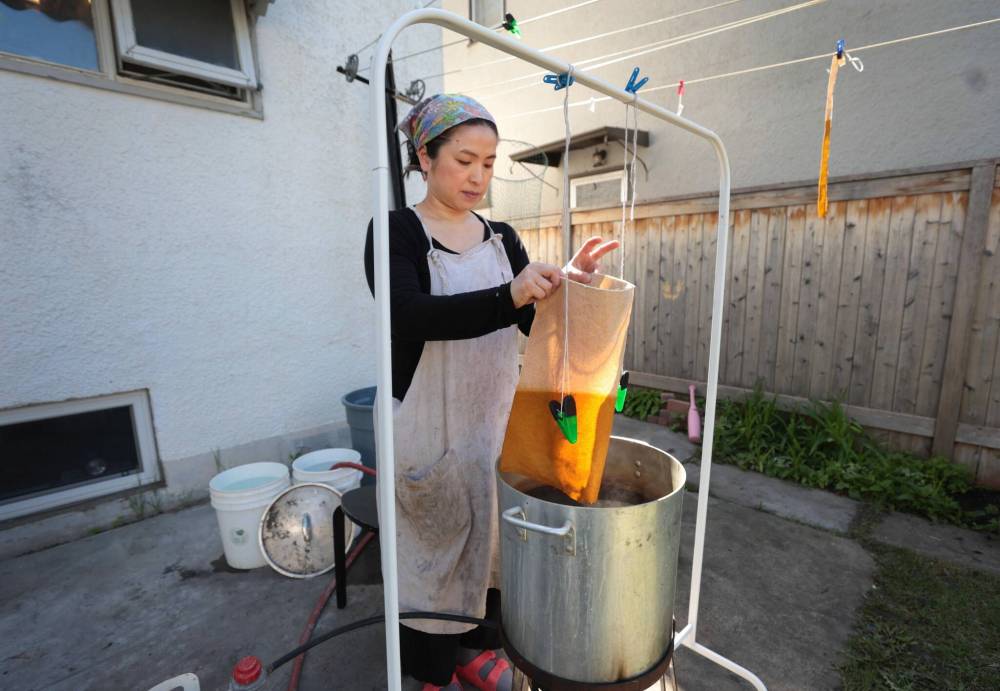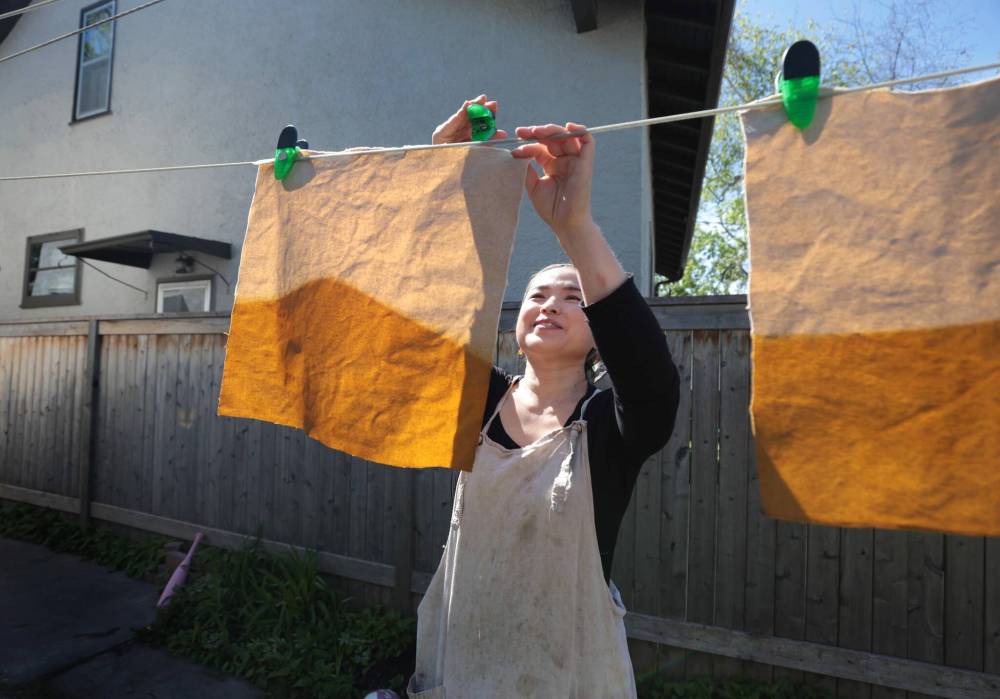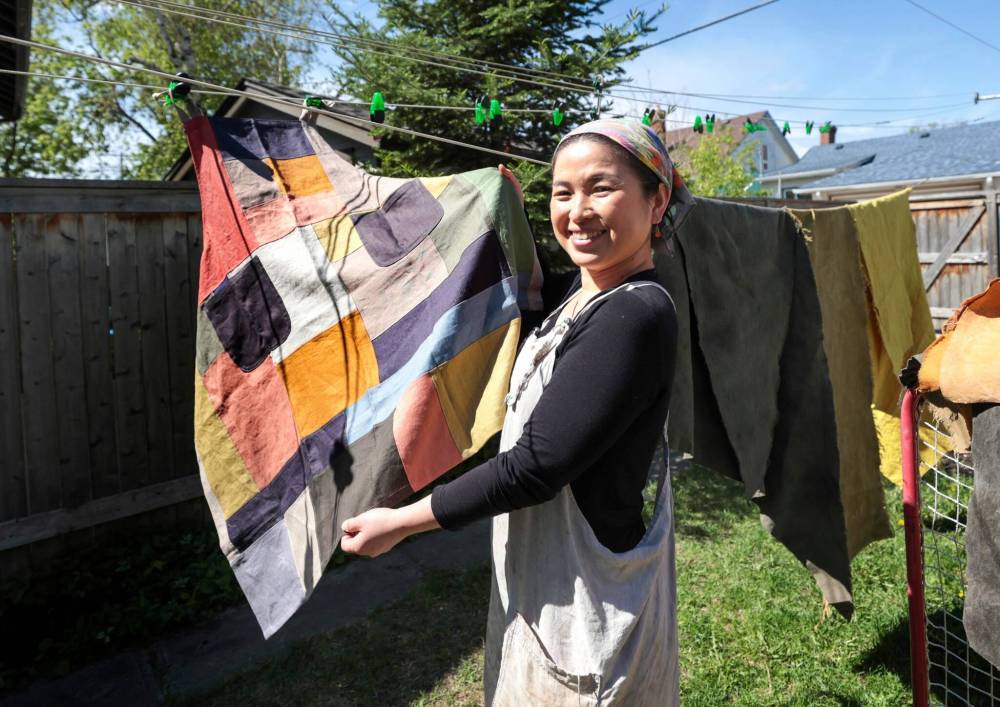Freshly dyed swathes of fabric flap on the clothes line in the back garden of Michino Tsuboi’s West End home.
When the materials dry Tsuboi, 47, will turn them into her Zudabukuro canvas bags, which she sells on her instagram account @michinos.textile, and at local markets and festivals. She’s currently busy preparing for July’s Winnipeg Folk Festival.

Tsuboi started making bags when, as a young mother, she struggled to find a durable receptacle to carry all the things she needed for her children.
All the bags she encountered were soft and shapeless, unsuitable for her needs. Tsuboi wanted something sturdy, something that wasn’t narrow, something she wouldn’t have to worry too much about.
Unable to find anything like that in the shops, she made one herself.
THE CREATORS
The Creators is a new series that examines the aha moment behind ideas, images and inspiration, and the people behind them.
“I wanted a bag that was original and unique but also one I didn’t have to worry about, and canvas was perfect to me,” she says.
Originally from Kusatsu, a city in the Shiga Prefecture, Japan, Tsuboi comes from a family of artists and grew up surrounded by art her parents had collected on their travels.
She was taught basic sewing in school, which sparked enough of an interest for the young Tsuboi to learn more advanced styles and how to make patterns from a retired tailor.
“Working in fabric gives me a bubbling feeling in my heart,” she laughs. “Some people who love books get really excited in a bookstore, when I go to the fabric store I feel naturally excited.”
As a teenager Tsuboi attended Doda Kogei Art High School in Kyoto, where she majored in printmaking and went on to become an illustrator. She moved to Canada in 2002 and met her husband. The couple moved back to Japan, returning three years later with their eldest child and expecting their second baby.
Busy raising a family — she now has four children — Tsuboi set her creative pursuits to one side.

In 2016 her children’s school invited parents to showcase their creative sides at an end-of-year fundraising art market.
It was the chance she needed to reignite her love of sewing.
She arrived with patchwork bags, made from pieces of salvaged fabric sourced from thrift and fabric stores, and was taken aback by how much people loved them.

“Around that time my good friend, who is also an artist, told me that she was interested in natural dyes. That inspired me, it gave me the same bubbling excited feeling I have when I am sewing bags, so I started to dye canvas,” she explains.
The following year Tsuboi turned up at the same art market fundraiser, this time with her own hand-dyed bags.
The bags are tinted with plants and flowers, such as marigolds and coreopsis which she grows in her backyard or foraged desert false indigo, alder corns, oak leaves and oak galls gathered during nature walks around Omand’s Creek and Little Mountain Park, and on camping trips to Blue Lake and Paint Lake.
She’s currently researching techniques on how to make a natural indigo bag, and participated in a workshop last summer in Tokushima Prefecture, Japan, said to be the birthplace of Japanese indigo dye.
“Indigo dye is very different from other natural dyes and you need a lot of space to grow indigo plants. My place is tiny, so right now I buy the powder from the store and use that to dye the bags. But everything else comes from my surroundings or my back garden,” she confides.

Tsuboi says the key to a successful dyeing outcome is to remain flexible. Most of the time the results are what she had envisioned but there are times when the unexpected occurs, not that she minds.
“My father, a paper-cut artist, says there is no mistake. If something comes out in a different way it gives you the chance to create different things. That is what he has always told me since I was a kid,” she shares.
This philosophy has held her in good stead. Everything she makes, even if it doesn’t go to plan, can be repurposed, redesigned or reimagined into something else.
In her eyes there are no imperfections or flaws, just ways to create something else.
av.kitching@freepress.mb.ca

AV Kitching
Reporter
AV Kitching is an arts and life writer at the Free Press. She has been a journalist for 24 years and has worked across three continents writing about people, travel, food, and fashion. Read more about AV.
Every piece of reporting AV produces is reviewed by an editing team before it is posted online or published in print — part of the Free Press‘s tradition, since 1872, of producing reliable independent journalism. Read more about Free Press’s history and mandate, and learn how our newsroom operates.
Our newsroom depends on a growing audience of readers to power our journalism. If you are not a paid reader, please consider becoming a subscriber.
Our newsroom depends on its audience of readers to power our journalism. Thank you for your support.